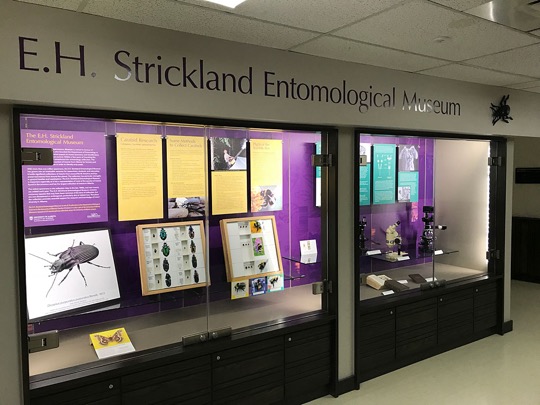2018 UAM Summer Internship: Arachnophobes Need Not Apply
Martin Bierens - 20 June 2018

Visit the E.H. Strickland Entomological Museum hallway display on the ground floor of BioSci
Since my last blog post I have changed gears from archaeology to entomology. Over the past two weeks I have been working in the E.H. Strickland Entomological Museum. What this means is that I have been working with bugs, spiders in particular! The E.H. Strickland Entomological Museum is one of the oldest museums at the University of Alberta, being founded in the mid-1920s in what was then the Department of Entomology. The Department of Entomology was merged with five other departments in the 1990s to create the Department of Biological Sciences.
While in the E.H. Strickland Entomological Museum, I had the chance to work with assistant curator, Danny Shpeley. What Danny has been getting me to work on is a very large donation of spiders that was donated to the Museum in 2017. This is a donation of about 26,000 spider specimens, from all over the world. Most of these spiders were collected in Canada, but there are also a great number from the United States, Mexico, Israel, and even more exotic places like Tanzania and Australia. I am taking a spider world tour from the comfort of my office chair! I have been slowly, but surely, making a dent in the donations, having completed work on around 400 specimens at the moment.
My job has been to refresh the alcohol, add an accession number into the vial, and database the information that is included on labels which are within the vials. These specimens are in vials that are filled with alcohol in order to preserve the spiders. Alcohol is used over pinning because spiders are soft-bodied, if they were pinned the spiders would shrivel up! So even though most of these spiders were collected in the 1960s, they look the same as the day that they were collected! The databasing is perhaps the most important part of my job. This is done on an Excel spreadsheet which will be uploaded to Mimsy, the University of Alberta Museums database. What makes these specimens valuable to the Museum is not necessarily the specimen itself, but the data. The data is what gives each specimen scientific importance. Information like where it was collected, the elevation, the habitat, and when it was collected can give researchers important knowledge of the species that they are looking at.
The reason for databasing is, much like my previous experiences in Bryan/Gruhn Archaeology Collection, to upload this data into an online database. This allows the public and researchers alike to learn more about a species and all that is involved with it. The most interesting part of the Virtual Museum for me was that you are able to see the distribution range of a species. Location is a crucial part of the databasing that I am doing, and the final product of thousands of data entries is a map where you can see the range of a species.
This data entry might not be the most glamourous work that I will be doing this summer, but it is perhaps some of the most important and valuable. Talking with the curator of the collection, Felix Sperling, he said something which has stuck with me, “On one hand this work is incredibly boring, but on the other it is incredibly important.” Databasing is a huge part of museum work, and this saying is probably the most accurate representation of it!
My time here at the E.H. Strickland is drawing to a close today, and I must say that I loved my time here! I have a newfound respect for bugs, and everything creepy crawly!